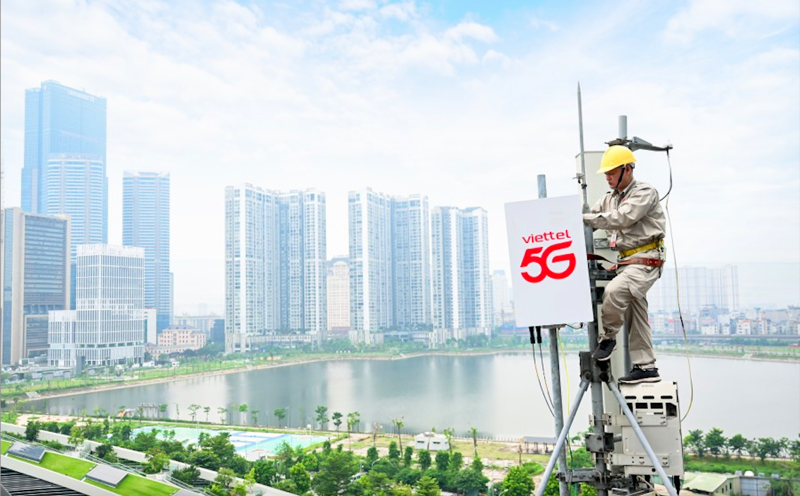Vietnam took its first concrete steps towards 5G commercialization in early 2024, with a major breakthrough coming in March when Viettel and VNPT secured 5G frequency bands through successful auctions, joined by MobiFone after it finalized its bid in July.
Progress over the year since has been remarkable. Viettel now operates over 6,500 5G BTS (Base Transceiver Stations), ensuring full coverage in Vietnam’s 63 cities and provincial capitals as well as industrial parks, tourist hubs, seaports, airports, hospitals, and universities. As of the end of January 2025, its 5G subscriber base had surged to 5.5 million users. Meanwhile, VNPT has also achieved nationwide 5G coverage, reaching all 63 cities and provinces, along with 705 district-level administrative units and key strategic areas. With around 3 million subscribers already on board, Vietnam’s 5G landscape is evolving at an unprecedented pace.
The country has set ambitious goals for telecommunications infrastructure this year, aiming for rapid advancements in digital connectivity. With telecom providers committed to expanding coverage and strong government backing through supportive policies, the country is poised for a major leap forward, especially in 5G deployment.
Paving the way
Updates on the nationwide 5G deployment plan were shared at the first meeting of the government steering committee for the development of science, technology, innovation, and digital transformation, and Project 06 on developing the application of population data, identification data, and e-authentication data, as well as administrative reforms. Mr. Tao Duc Thang, Chairman and CEO of the Viettel Group, announced that the corporation aims to reach 20,000 5G BTS by the end of 2025, more than doubling the current 5G data transmission speed, by 2.5-fold.
Following the issuance of Resolution No. 03/NQ-CP, outlining a comprehensive action program to implement Politburo Resolution No. 57-NQ/TW on breakthroughs in science and technology development, innovation, and digital transformation, Viettel acted decisively, streamlining procedures, reporting to the Ministry of National Defense, and completing the necessary bidding processes. The company expects the first batch of equipment to arrive as early as August and is mobilizing all resources to ensure all stations are operational by December. “This is our roadmap for 5G expansion,” Mr. Thang said. “Once completed, we will achieve comprehensive high-speed 5G coverage across cities, districts, urban areas, industrial parks, and tourist destinations, while also bringing 4G connectivity to remote regions.”
Viettel is not alone in this race. VNPT has also set ambitious goals, planning to triple its 5G coverage in 2025 and serve 99 per cent of the population. It is focused on upgrading its telecom infrastructure, optimizing spectrum usage to ensure stable connectivity even in high-density areas, and collaborating with technology partners to maximize 5G’s potential in digital economy applications, e-government, and smart city services.
Meanwhile, MobiFone is also stepping up, targeting the deployment of 10,000 new 5G BTS to extend its coverage to 100 per cent of communes nationwide. The company plans to officially commercialize 5G services between late March and early April. In addition to network expansion, it is investing in 5G-based service solutions, including virtual reality (VR) communication, the Internet of Things (IoT), and big data platforms, enabling businesses and individuals to fully leverage the power of next-generation technology.
According to Ericsson’s research, by 2029, 5G will account for approximately 50 per cent of all mobile subscriptions in Vietnam. Over 25 per cent of the country’s data traffic is now transmitted via 5G, solidifying its role as a key driver of Vietnam’s digital economy. “5G is more than just high-speed mobile broadband,” said Ms. Rita Mokbel, Head of Ericsson Vietnam. “When combined with cloud computing and AI, its potential expands far beyond.”
This rapid deployment is not only narrowing Vietnam’s technology gap with developed countries but also creating a dynamic environment for innovation, fostering the growth of tech enterprises, and attracting foreign investment into the telecommunications sector. More than just a milestone for the telecom industry, this acceleration in 5G infrastructure is set to be a crucial catalyst for Vietnam’s comprehensive digital transformation in the years ahead.
For a connected future
In alignment with the growth of telecom enterprises, the Vietnamese Government has introduced crucial support policies. Politburo Resolution No. 57 underscores the State’s commitment to substantial investments in digital infrastructure, including 5G networks and submarine fiber optic cables, as a foundation for national development.
Following this, National Assembly Resolution No. 193/2025/QH15 on piloting special mechanisms and policies to create breakthroughs in national science, technology, innovation, and digital transformation formalizes this strategy. Telecom providers investing in 5G infrastructure will receive government support of up to 15 per cent of total investment value if they deploy at least 20,000 BTS by 2025. This special incentive acts as a key catalyst for accelerating nationwide 5G coverage within the year.
Minister of Science and Technology Nguyen Manh Hung revealed that within the first week of Resolution No. 193’s issuance, two Vietnamese enterprises committed to increasing 5G investment by four to five-times compared to 2024, significantly boosting the country’s mobile network speed.
Over the past six years, Vietnam’s telecom ranking has surged from 108th to 72nd globally, averaging an annual improvement of six places. If this momentum continues, Vietnam could break into the world’s top 50 telecom nations by 2030, and with even greater effort possibly the top 40.
The national strategy aims to achieve full fiber-optic coverage for households by 2025, ensuring that all cities and provinces, high-tech parks, information technology (IT) hubs, research and development (R&D) centers, innovation zones, industrial parks, and key transport hubs, including ports and airports, are equipped with 5G services. Given current progress, this goal appears within reach.
By 2030, 100 per cent of users will have access to fiber-optic connections with speeds of at least 1Gb/s, and 5G mobile broadband is expected to cover 99 per cent of the population. The country will be equipped to trial 6G networks.
Compared to previous generations (2G, 3G, and 4G), the number of BTS required for 5G is significantly higher. While 2G needed just 20,000 to achieve nationwide coverage, 3G required 30,000-35,000, and 4G required 40,000-60,000. In contrast, full 5G coverage could necessitate up to 200,000 BTS; an ambitious target given the massive capital investment required for end-user devices, coupled with unresolved questions about economic viability. The market’s ability to adopt and leverage 5G technology in the years ahead will ultimately determine the feasibility of this expansion.
Beyond increasing the number of 5G BTS, Vietnam is also easing regulations to develop low Earth orbit (LEO) satellite telecom infrastructure through foreign technologies. Resolution No. 193 allows for pilot programs with up to 100 per cent foreign ownership, provided national security and sovereignty concerns are addressed. This marks a significant step towards positioning Vietnam as an attractive market for global telecom service providers.
Vietnam is also advancing its subsea cable infrastructure, with the second submarine cable system, ALC, expected to be operational in 2026. Meanwhile, the third international fiber-optic cable, a joint project between Vietnam and Singapore, is set to begin construction in 2027 and be completed by 2028.









 Google translate
Google translate